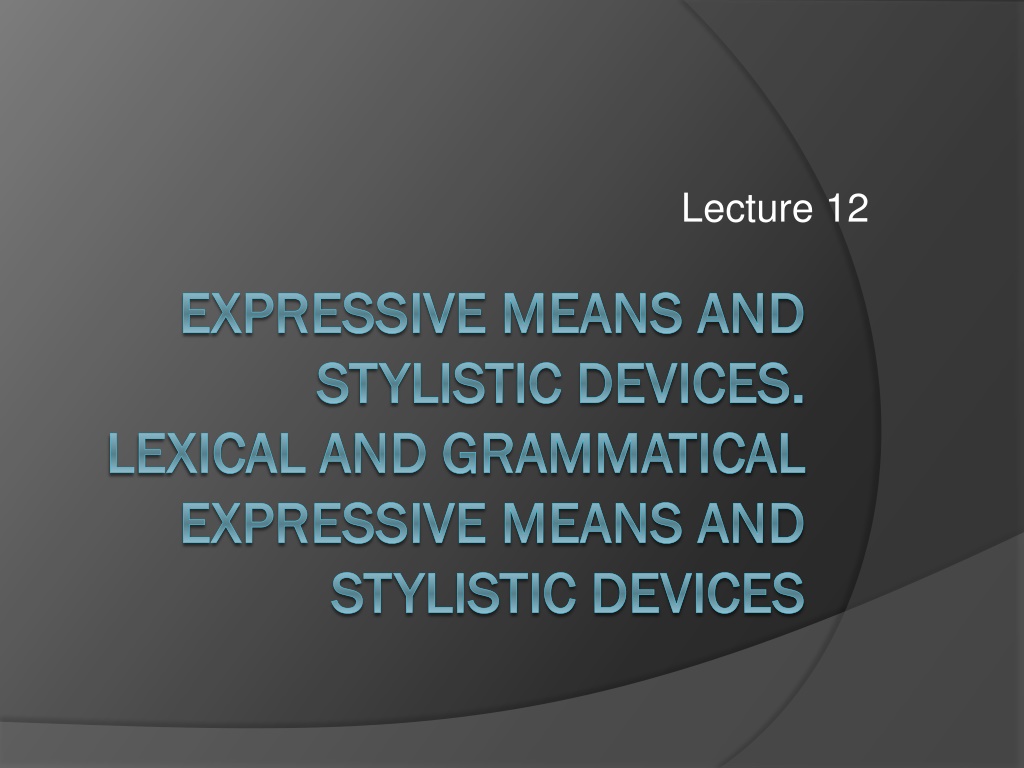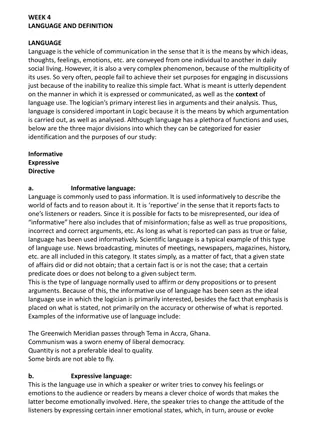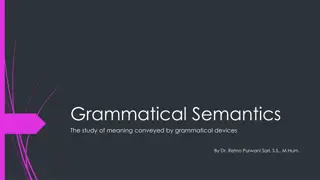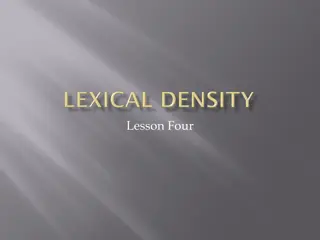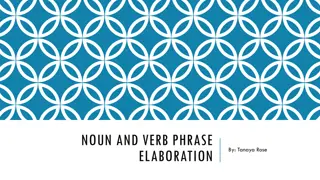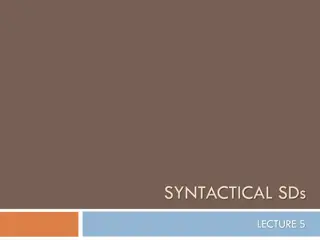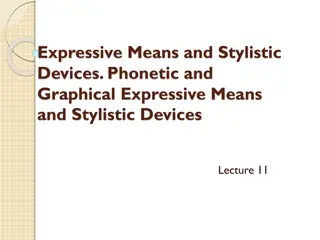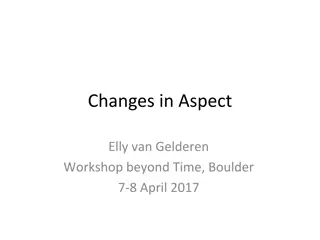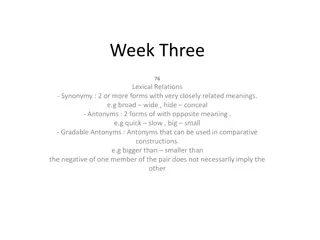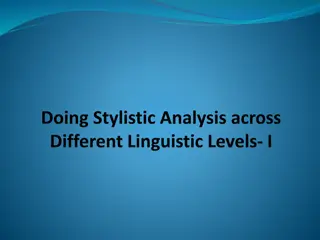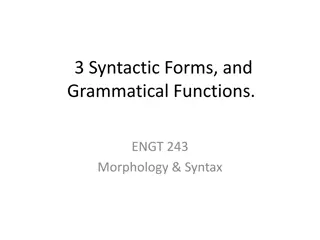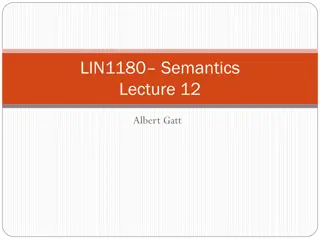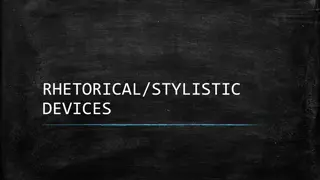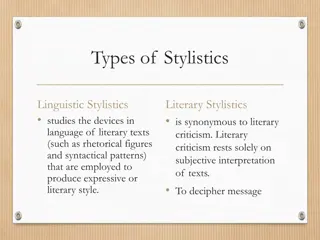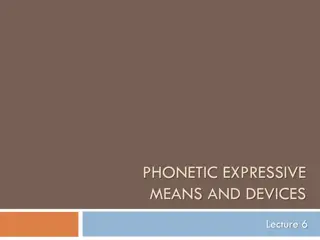Understanding Lexical and Grammatical Expressive Means in Stylistic Devices
The lecture discusses various lexical and grammatical expressive means in stylistic devices, such as metaphor, personification, allusion, metonymy, synecdoche, irony, epithet, and oxymoron. These tools allow for creative and vivid expressions in language by playing with different meanings and associations. Through examples and explanations, the lecture explores how these devices enhance the aesthetic and communicative aspects of literary and everyday language usage.
- Lexical expressive means
- Grammatical expressive means
- Stylistic devices
- Language usage
- Creative expressions
Download Presentation

Please find below an Image/Link to download the presentation.
The content on the website is provided AS IS for your information and personal use only. It may not be sold, licensed, or shared on other websites without obtaining consent from the author. Download presentation by click this link. If you encounter any issues during the download, it is possible that the publisher has removed the file from their server.
E N D
Presentation Transcript
Lecture 12 EXPRESSIVE MEANS AND EXPRESSIVE MEANS AND STYLISTIC DEVICES. STYLISTIC DEVICES. LEXICAL AND GRAMMATICAL LEXICAL AND GRAMMATICAL EXPRESSIVE MEANS AND EXPRESSIVE MEANS AND STYLISTIC DEVICES STYLISTIC DEVICES
12.1. Lexical Expressive Means and Stylistic Devices. 12.2. Grammatical Expressive Means and Stylistic Devices.
Lexical Expressive Means and SD Lexical Expressive Means and SD Metaphor is a relation between the dictionary and contextual logical meanings based on the similarity of certain properties or features of the two corresponding concepts. e.g. Through the open window the dust danced and was golden. Personification is a transfer of features and characteristics of a person to a thing (very often nature); prescribing to a phenomenon qualities, feelings and thoughts of a human being. Slowly, silently, now the moon walks the night in her silvery shoes. (de la Mare)
Lexical Expressive Means and SD Lexical Expressive Means and SD Allusion is a brief reference to some literary or historical event or character commonly known. e.g. The rise in poverty will unlock the Pandora s box of crimes. Metonymy is based on some kind of association connecting the two concepts which these meanings represent. Proximity may be revealed in the relations between: the symbol and the thing it denotes; The crown (the royal family); the instrument and the action performed with this instrument; e.g. His pen is rather sharp. the container and the thing it contains; e.g. He drank one more cup. when the specific is put for the abstract; e. g. It was a representative gathering (science, politics). when a part is put for the whole; e.g. a hand worker.
Lexical Expressive Means and SD Lexical Expressive Means and SD Synecdoche is the transfer of the meaning on the basis of association between a part and the whole, the singular and the plural. e.g. the blue-coat ( policeman). In synecdoche a part is named but the whole is understood. Irony is based on the simultaneous realization of two logical meanings dictionary and contextual, but the two meanings are in opposition to each other. One thing is said and the opposite is implied. e.g. This naturally led to some pleasant chat about... fevers, chills, lung diseases ... and bronchitis. (J.K.Jerome)
Lexical Expressive Means and SD Lexical Expressive Means and SD The epithet is based on the interplay of emotive and logical meanings in an attributive word, phrase or even sentence, used to characterize an object and pointing out to the reader some of the properties or features of the object with the aim of giving an individual perception and evaluation of these features or properties. It gives not logical but expressive characteristics (both real and imaginary) of a thing or person. e.g. He looked at them in animal panic. (M. Wilson) Oxymoron is a combination of two words with opposite meanings which exclude each other: e.g. speaking silence, cold fire. "The silence was louder than thunder".
Lexical Expressive Means and SD Lexical Expressive Means and SD Zeugma is a simultaneous realisation of two meanings of a polysemantic unit. It is the use of a word in the same grammatical but different semantic relations to the adjacent word in the context, the semantic relations being on the one hand literal, and on the other, transferred. The primary and derivative meanings clash. e.g. Everything was short including tobacco and people's tempers. (E. Hemingway) Pun/ paronomasia/ play on words is a device based on polysemy, homonymy or phonetic similarity used to achieve a humorous effect. e.g. I wonder if I can see your mother, little boy. Is she engaged? Engaged?! She's married. (engaged 1. ; 2. )
Lexical Expressive Means and SD Lexical Expressive Means and SD Antonomasia a proper name is used instead of a common noun or vice versa (it gives additional information about the bearer of the name). There are two types: When the proper name of a person, who is famous for some reasons, is put for a person having the same features, e.g. He is the Napoleon of crime (C. Doyle). A common noun is used instead of a proper name, e. g. the three I'm referring to are Dr. Rest, Dr. Diet and Dr. Fresh Air." (D. Cusack).
Lexical Expressive Means and SD Lexical Expressive Means and SD Simile is based on comparison of two objects or notions belonging to different spheres of life. The objects compared are not identical, though they have some resemblance, some common features. Emphasising their partial identity gives new characteristics to the referent. e.g. Unhappiness was like a hungry animal waiting beside the track for any victim (G. Greene). Simile is based on a certain image while in grammatical comparison two objects belong to the same class, e.g. She was as tall as her father (gr. comp.) She was as tall as an elm. (simile) Formally, the simile is manifested: grammatically, with the help of conjunctions (as if; as thought, like, than, as as lexically, by means of the words expressing likeness (remind, resemble, seem, appear). e.g. He reminded me of a hungry cat.
Lexical Expressive Means and SD Lexical Expressive Means and SD Hyperbole is a deliberate overstatement, exaggeration that is used to intensify one of the features of the object. e.g. The coffee shop smell was strong enough to build a garage on. (R. Chandler) Understatement/ Meiosis is lessening, weakening, underrating, reducing the real characteristics of the object of speech. It serves to underline the insignificance of what we speak about, e.g. She wore a pink hat, the size of a button. (J. Reed).
Lexical Expressive Means and SD Lexical Expressive Means and SD Periphrasis is a word combination which is used instead of one word, designating an object. Periphrasis indicates the feature of the notion which impresses the writer most of all, and it conveys a purely individual perception, e.g. Under his arm he bore the instruments of destruction (guns/revolver). As a result of frequent repetition, periphrasis can become well-established as a synonymous expression for the word generally used to designate the object, e.g. the better (fair, gentle) sex (women), my better half (my spouse).
Lexical Expressive Means and SD Lexical Expressive Means and SD Euphemism - a variant of periphrasis which is used to replace an unpleasant, hush or blunt word or expression by a conventionally more acceptable, mild or vague one. 1. Religion, e.g. God Goodness, Lord, etc.; Devil the dickens, old Nick, old Harry. 2. Death, e.g. to die to join the majority, to pass away, to go west, etc; 3. Politics, starvation the poor less fortunate elements, etc. Decomposition (violation) of set phrases consists in intentionally violating the traditional norms of the use of set phrases. The ways a set phrase may be decomposed are various: 1. The author's intrusion an insertion of a word into a set phrase, e.g. She took a desperate ungovernable hold of him. 2. Prolongation e.g. Little John was born with a silver spoon in his mouth, which was rather curly and large. 3. Fusion of two phrases into one 4. Changes of proverbs and sayings e.g. She was born with a golden spoon. Southerners were born with guns at their hands.
Syntactical Expressive Means and SD Syntactical Expressive Means and SD Inversion is the violation of the fixed word order within an English sentence. There are two major kinds of inversion: grammatical (exclamatory and interrogative sentences) and stylistic (it adds an emotive and emphatic colouring ), e.g. And the palm-trees I like them not (A. Christie). Inversion may be of two types: complete and partial. Detached constructions are to be regarded as a special kind of inversion, when some parts of the sentence are syntactically separated from its other members with which they are grammatically and logically connected. e.g. Formidable and ponderous, counsel for the defense arose (A. Christie). She was gone. For good. The word-order here is not violated, but secondary members obtain their own stress and intonation because they are detached from the rest of the sentence by commas, dashes or even a full stop.
Syntactical Expressive Means and SD Syntactical Expressive Means and SD Repetition is recurrence of the same word, word combination, or phrase for two and more times. According to the place which the repeated unit occupies in a sentence (utterance), repetition is classified into several types: Anaphora repetition of the first word or word-group in several successive sentences, clauses or phrases; Epiphora repetition of the final word or word-group; Anadiplosis (catch repetition) repetition at the beginning of the phrase, clause or sentence of a word or a word-group that has occurred in initial, the middle or the final position of the preceding word-sequence; Framing, or ring repetition repetition of the same unit at the beginning and at the end of the same sentence or paragraph, Chain repetition presents several successive anadiploses ...a, a...b, b...c, c. The effect is that of the smoothly developing logical reasoning.
Syntactical Expressive Means and SD Syntactical Expressive Means and SD Parallel constructions are based upon a recurrence of syntactically identical sequences which lexically are completely or partially different. e. g. "She was a good servant, she walked softly, she was a determined woman, she walked precisely. Chiasmus (reversed parallel construction) is based on the repetition of a syntactical pattern, but it has an inverted order of words and phrases. e.g. Down dropped the breeze. The sails dropped down. (Coleridge) He sat and watched me, I sat and watched him.
Syntactical Expressive Means and SD Syntactical Expressive Means and SD Suspense (retardation) is arranging the matter of a communication in such a way that the less important, subordinate parts are amassed at the beginning, the main idea being withheld till the end of the sentence. Thus the reader's attention is held and his interest is kept up. Sometimes the conclusion of the suspended utterance goes contrary to the aroused expectations. Climax (gradation) is an arrangement of sentences (or homogeneous parts of one sentence) which secures a gradual increase in significance, importance, or emotional tension in the utterance. In climax we deal with strings of synonyms or at least semantically related words belonging to the same thematic group. A gradual increase in significance may be maintained in three ways: 1) logical, 2) emotional and emphatic, 3) quantitative
Syntactical Expressive Means and SD Syntactical Expressive Means and SD Anticlimax is the reverse of climax. It may be of two types: An arrangement of ideas in ascending order of significance gradual drop in intensity; The initial items may be poetical or elevated, but the final one, which the reader expects to be the culminating one, as in climax, is trifling. A sudden drop from the lofty or serious to the ridiculous. It's sudden break in emotive power. Antithesis is based on relative opposition arising out of the context through the expansion of contrasting pairs. Antithesis emerges as a result of a contraposition of two or more words, the words being either antonyms, as in: brief long, or contrastive in some of their meaning-components as in: wrath friendship.
Syntactical Expressive Means and SD Syntactical Expressive Means and SD Asyndeton is a deliberate avoidance of conjunctions in constructions in which they would normally be used. e.g. He couldn't go abroad alone, the sea upset his liver, he hated hotels. Polysyndeton is an identical repetition of conjunctions. e. g. The heaviest rain, and snow, and hail, and sleet, could boast of the advantage over him in only one respect. (J. Priestley)
Syntactical Expressive Means and SD Syntactical Expressive Means and SD Ellipsis is the omission of a word necessary for the complete syntactical construction of a sentence, but not necessary for understanding. Ellipsis is mainly used in dialogue to reflect the natural omissions characterizing oral colloquial speech; in author's introductory remarks to comment on the speech of the characters. e. g. You feel all right? Anything wrong or what? Break-in-the-narrative is a sudden intentional break in the narration or dialogue. It reflects the emotional/ psychological state of the speaker: 1) the speaker's emotions prevent him from finishing it, 2) the desire to cut short the information with which the sentence began. e. g. On the hall table there were a couple of letters addressed to her. One was the bill. The other... I'm sorry, Thomas.
Syntactical Expressive Means and SD Syntactical Expressive Means and SD Nominative (one-member) sentences consist only of a nominal group, which is semantically and communicatively self-sufficient. In creative prose one-member sentences are mostly used in descriptions (of nature, interior, appearance, etc.), where they produce the effect of a detailed but laconic picture. Rhetorical question is one that expects no answer. It is asked in order to make a statement rather than to get a reply. e.g. What was the good of discontented people who fitted in nowhere? Is the day of the supernatural over? (A. Christie).
Syntactical Expressive Means and SD Syntactical Expressive Means and SD Litotes is a peculiar use of negative constructions aimed at establishing a positive feature in a person or thing. e.g. He was not without taste ... He is not uncultured. Her face was not unhandsome. Usually litotes presupposes double negation. One through a negative particle (no, not), the other through a word with negative meaning. Its function is to convey doubts of the speaker concerning the exact characteristics of the object or a feeling. e.g. He is no coward. He is a brave man.
